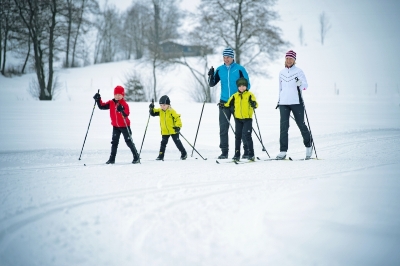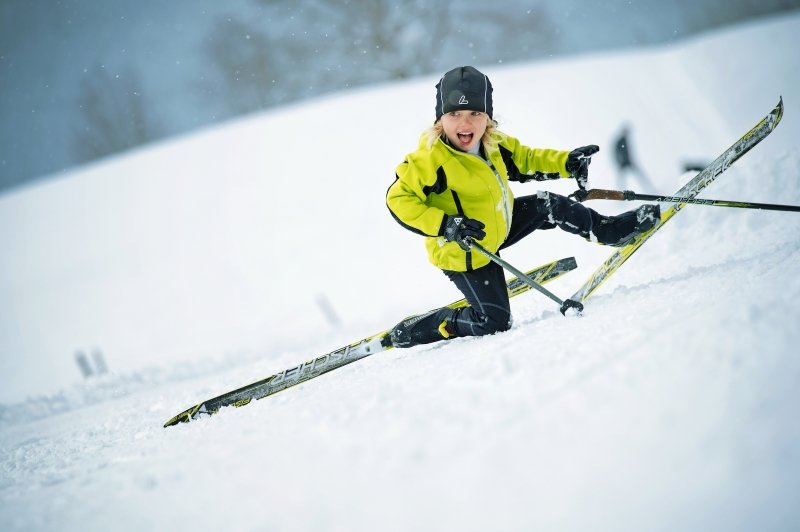We excitedly planned a weekend trip to Jackson, NH, because it is a true Mecca for Nordic skiers. This is the quintessential New England Nordic (XC) skiing experience with the covered bridge, white steepled church, brookside trails, and the accompanying village with all of the trappings.
Many of the trails lead right to the door of local inns, shops, and restaurants. It's no wonder that Jackson XC has been rated the top cross country ski area in the United States by the website, America's Best Online.
The Foundation is a non-profit organization chartered to maintain XC ski trails in and about the village of Jackson. There are about 75 landowners that allow trails to cross their property. Country inns are spaced throughout the region and the base lodge is a golf country club located on the village loop. The Cocoa Cabin is a warming hut serving hot cocoa on the weekend, located 3 km from the center on the gentle Ellis River Trail. Snowshoers can take a rustic narrow marked snowshoe trail from the center to reach the Cocoa Cabin.
We stopped at nearby Bretton Woods Nordic Center on the way to Jackson to ski in a snow storm for about 10 km on beautiful trails behind the Omni Mt. Washington Hotel. The grand hotel is at the southern base of the mighty Mt. Washington with 1,700 acres of spectacular scenery. This full service ski center has its own parking area and houses the ski school, rental equipment, and a retail shop with XC ski clothing and accessories. The center has a fireplace with couches and food service with tables and seating.
We arrived at the Inn at Ellis River in Jackson after leaving Bretton Woods and were showed to our room-with-a-view by new innkeepers John and Mary Kendzierski. The next morning we awoke to the aroma of bacon, which while incredible, does not do justice to how good the maple bacon tastes when accompanying a choice of two hot entree specialties such as cinnamon crepe stuffed with apple filling and topped with creme fraiche or pecan praline French toast. There's also fruit, yogurt, granola, and freshly baked breads, muffins, and other breakfast treats. The breakfast tables were covered antique metal sewing treadle tables. Looking out the windows from the dining room adorned with snowman figurines, we saw frolicking squirrels hopping from tree branch to tree branch.
Behind the inn and across the Ellis River is the Ellis River Trail, one of the most popular trails from the center lodge for XC skiers and snowshoers. We first stopped by the Jackson XC and got my wife's skis hot waxed as we waited. The wax job worked like a charm as we left the center for a short tour through the covered bridge, ending up at the Cocoa Cabin. The skiers along the Jackson trails are mostly experienced and courteous meaning they give the right of way to downhill skiers and get out of the groomed ski tracks when appropriate. Most say hello as they pass.
We lunched on scrumptious sandwiches at the J-Town Deli & Country Store, a warm and enticing old-fashioned country store that has a bakery, beer, wine, sweets and treats.
The "Foundation" maintains 150 km of varied and breathtaking XC ski and snowshoe trails 2 hours north of Boston. Foundation trails connect with A.M.C. trails in Pinkham Notch and White Mountain National Forest backcountry adventure trails.
Our après ski time led us to the Wildcat Inn Tavern in downtown Jackson for some live music and libations. The tavern walls display classic ski posters and some antique gear such as snowshoes and a pair of red Jarvinen XC skis. The seats in one of the rooms were built to look like double chairlifts and there were soccer jerseys from around the world pinned to the ceiling. Afterward, we dined at the nearby Christmas Farm Inn for a great dinner and dessert.
Our getaway day included a stop and tour at Great Glen Trails Outdoor Center, about ten miles outside of Jackson up the Pinkham Notch toward Gorham. The panorama view from the center of the Presidential Range and Mt. Washington is unparalleled. We skied a few cold and windy kilometers on wide whimsically-named trails such as the Great Grump Grade and Hairball Passage toward the Great Angel Warming Cabin. The trails were impeccably groomed and on our way back to the lodge we stopped by the new Glen House Hotel for a drink and lunch. The hotel has 68 rooms and is one of the most sustainable operations in the business. We also checked out the Mt. Washington SnowCoach to head up to treeline on the nearby Toll Road, which is an experience not to be missed.
The White Mountains and Jackson met our expectations delivering great snow, excellent trails, and a superb weekend at a destination worthy of being named a Mecca of Nordic skiing.
Family of XC skiers at Great Glen Trails



















